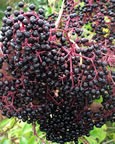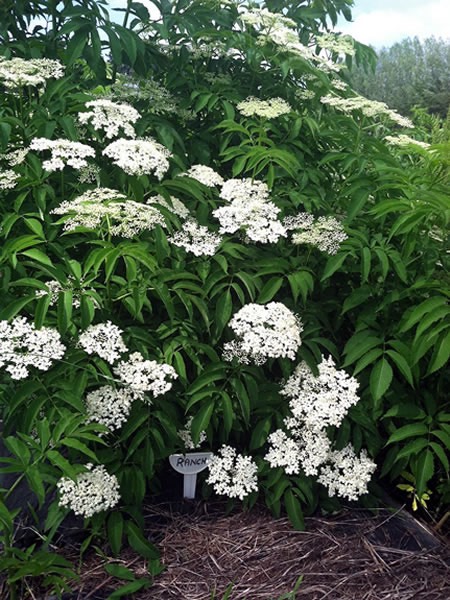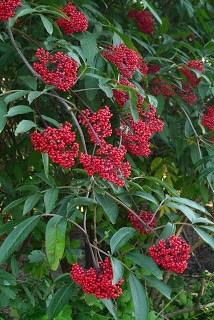Grow This Fruit-Garden Favorite
The elderberry often occupied a favored spot in the old-fashioned fruit garden—perhaps a corner where it could grow undisturbed, its branches spreading to 8 feet when laden with fruit, the plant itself growing about 12 feet under good conditions. In early July, the glorious elder blossoms, or elderblow, were picked for wine and jelly making. The buds were pickled, the florets were shaken into pancake and muffin batters to lighten and sweeten them.
Later in the season, before the first frosts of autumn, the clusters of shiny purple-black fruit were picked mainly for wine making, although elderberry jelly and pie were also looked on with great favor. The experienced cook knew just where to find the hard sour green apples that, when combined with elderberries, made a firm, flavorful jelly. (Unlike many other small fruits, elderberries do not contain much natural pectin.) Large trays of ripe elderberries were set out in the sun to dry so that elderberry pie could be enjoyed throughout the winter. [Article continues with four recipes.] Read More
North American Sambucus nigra canadensis
The "elder" in elderberry comes from Old Saxon "aeldar", which means "fire". The stunning, aromatic flower clusters and mildly sweet fruit of elderberry have been treasured for thousands of years. The dark purple berries are very high in vitamin C, and they are a great source of Vitamin A - up to ten times more than more popular berries. But elderberry is more noted for its high levels of antioxidants like flavonoids — mainly anthocyanins, as well as quercetin and rutin, which function as a cellular level anti-inflammatory agents.
More nutrient dense than most other berries, elderberry juice and extracts have been used to treat the common cold, flu, diabetes and even some forms of cancer. Compare some of the US Department of Agriculture’s data displayed on the Photos and Tables page.
These facts, among others, have encouraged the North American cultivation of various regional varieties in order to provide more nutrients at lower cost. Commercial elderberry cultivation is becoming a vital part of sustainable agriculture in North America, and the number of acres dedicated to elderberry cultivation is growing. While some focus on producing their own versions of traditional elderberry products as sold in European markets, many American growers and elderberry entrepreneurs are focusing on the innovative use of elderflowers and elderberries as ingredients in various foods and beverages, favoring a “less processed is better” approach to elderberry products.

One example of the growing number of North American food processors exclusively using Sambucus canadensis berries, primarily sourced from the Midwest, is River Hills Harvest. Their juice products are not made from elderberry concentrate but from minimally processed, undiluted juice as an end product or core ingredient. River Hills Harvest cool processes elderberry juice for only about four minutes at 160-180°F, so the sweet neutral juice tastes great, less bitter, and retains more nutrient vitality.
River Hills Harvest products are always sustainably grown and plans for a certified organic line of products in the future. Their products are sold through a growing network of local food cooperatives and grocery stores that focus on quality natural or organic, locally grown and processed foods and juice.
A Walk on the Wild Side: Elderberries
Excerpts:
...Elderberries are pretty plants that can vary in size and fullness depending on growing conditions. In deep shade, plants might reach only 3’-5’ and appear quite lanky, while those growing in good soil with more sun might reach upwards of 10’ tall and 6’ in diameter. Elderberries are often found growing in small groups or colonies in everything from sandy loam, to gravel, to heavy clay. Look for them in moist forest clearings, field edges, and along streams and ditches. Wherever elderberries are growing in the wild, you can be sure there is a reliable source of subsurface moisture... Only dark-fruited elderberries are safe to eat. The fruits of all red elderberry species should never be consumed in any form...
When ripe, the berries of common elderberry are small, hairless and globular (not perfectly round) and turn various shades of deep purple, black and blue. Only fully ripe berries should be eaten. The flavor and sweetness of wild elderberries can vary from plant to plant, so tasting the berries before picking is always a good idea. Never eat red elderberries — or the leaves, stems and roots of any elderberry species — as these contain toxic alkaloids and cyanogenic glycoside which can cause severe vomiting and diarrhea. During my research I came across claims that eating large quantities of the ripe, raw fruits of common elderberry may cause mild nausea, stomachache and diarrhea, so avoid eating a lot of fresh berries until more information can be found. The good news is that elderberries are better when cooked with a bit of sweetening anyway...

Elderberries: Red, White and Blue
Excerpts from the Green Deane's article:
Elderberries are nutritious, are packed with antioxidants, and have more Vitamin C than oranges or tomatoes. They also have Vitamin A, calcium, thiamine, niacin, twice the calories of cranberries and three times the protein of blueberries. They put grapes to shame, and man is not the only consumer. Over four dozen kinds of birds like elderberries as well as the occasional rodent and butterfly. Bears really like them — ripe or unripe — and deer and moose will nibble on them. The elderberry is in the honeysuckle family and have too many medicinal uses to mention here. They are one of the mainstays of herbalism and home remedies. Wherever it grows it has been the local pharmacy. Its botanical name is Sambucus canadensis (sam-BEW-kus kan-uh-DEN-sis).
Red Elderberries - Sambucus racemosa
Over the years I have had more than a few inquiries about red elderberries, and my typical answer is that they should be avoided. However, they were an emergency food source for Native Americans, more commonly in the Pacific Northwest than in the Midwest. This blog link takes you to one person’s experiment with duplicating those native practices with a dried fruit leather made from these berries.
[Click here to read more.]
THE ELDER-TREE MOTHER
by Hans Christian Andersen
A translation of hans christian Andersen's "hyldemoer" by Jean Hersholt. In this fairy tale you will note that the European elder grows in tree form while native North American elder grows as canes, though some can become quite old and large.